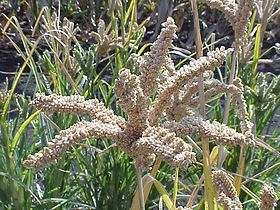|
Ragi is suited for cultivation in areas with annual rainfall of 700-1200mm. it does
not tolerate heavy rainfall and requires a dry spell at the time of grain ripening.
It grows well in altitudes of 1000-2000m with average temperature of 27oC.
Ragi is cultivated mostly in red lateritic soils. Relatively fertile and well drained
soils are the most suitable.

Seasons
Ragi is not a season bound crop and hence can be cultivated throughout the year,
if moisture is available.
Main season: June- September
Late season: July- Oct
Summer : Dec-Jan to March-April
Varieties
PR-202, K-2, Co-2, Co-7, Co-8, Co-9, Co-10
Seed rate:
Direct sown crop : 5kg/ha
Transplanted crop : 4-5kg/ha
Spacing : 25 x 15cm
Preparation of nursery
Prepare the nursery field to fine tilth. Incorporate FYM/ compost 5t/ha and form
beds and channels. Sow seeds uniformly on the beds and cover by stirring the soil.
Apply carbaryl 10% on the edges of the beds against ants. One week before uprooting
seedlings apply ammonium sulphate @ 1kg/ 100m2. A nursery area of 480
m2 is necessary to raise seedlings for one ha. Transplant the seedlings
when they are three weeks old.
Preparation of main field and manuring
Plough the field 3-4 times and incorporate FYM or compost 5t/ha. Apply N, P2O5
and K2O @ 22.5 kg/ha each before sowing planting. Topdress N at 22.5
kg/ha 21 DAS or planting.
After cultivation
Weeding should be done 3 weeks after sowing and completed before topdressing.
Irrigation
Irrigate the field on the day of transplanting. Irrigation at weekly intervals increases
growth rate and yield.
Plant protection
For controlling grass hoppers, spray carbaryl 50% WP @ 1.2 kg/ha. The pink stem
borer, which causes dead heart symptoms, is often serious in the early stages of
the crop. Insecticidal control is not needed for mild to moderate levels of infestation.
For controlling blast, spray mancozeb 750-1000g/ha.
Harvesting
Harvest the crop when the ears are yellowish brown. Heap the harvested ears and
cover the heaps with ragi straw for 2-3 days before threshing.
Top
|